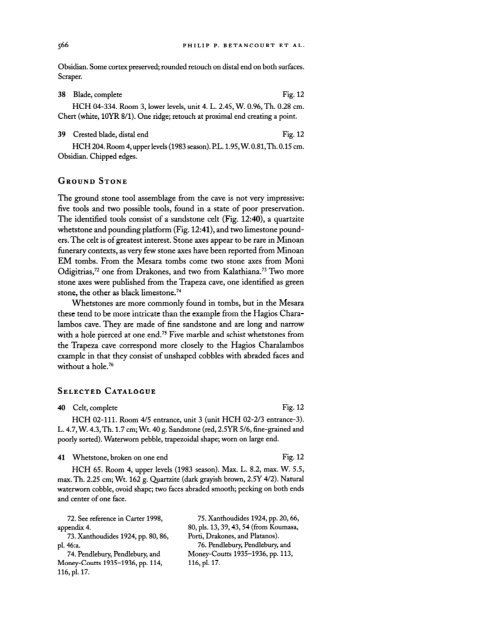Download - The American School of Classical Studies at Athens
Download - The American School of Classical Studies at Athens
Download - The American School of Classical Studies at Athens
You also want an ePaper? Increase the reach of your titles
YUMPU automatically turns print PDFs into web optimized ePapers that Google loves.
566<br />
PHILIP P. BETANCOURT ET AL.<br />
Obsidian. Some cortex preserved; rounded retouch on distal end on both surfaces.<br />
Scraper.<br />
38 Blade, complete Fig. 12<br />
HCH 04-334. Room 3, lower levels, unit 4. L. 2.45, W. 0.96, Th. 0.28 cm.<br />
Chert (white, 10YR 8/1). One ridge; retouch <strong>at</strong> proximal end cre<strong>at</strong>ing a point.<br />
39 Crested blade, distal end Fig. 12<br />
HCH 204. Room 4, upper levels (1983 season). PL. 1.95, W. 0.81,Th. 0.15 cm.<br />
Obsidian. Chipped edges.<br />
Ground Stone<br />
<strong>The</strong> ground stone tool assemblage from the cave is not very impressive:<br />
five tools and two possible tools, found in a st<strong>at</strong>e <strong>of</strong> poor preserv<strong>at</strong>ion.<br />
<strong>The</strong> identified tools consist <strong>of</strong> a sandstone celt (Fig. 12:40), a quartzite<br />
whetstone and pounding pl<strong>at</strong>form (Fig. 12:41), and two limestone pounders.<br />
<strong>The</strong> celt is <strong>of</strong> gre<strong>at</strong>est interest. Stone axes appear to be rare in Minoan<br />
funerary contexts, as very few stone axes have been reported from Minoan<br />
EM tombs. From the Mesara tombs come two stone axes from Moni<br />
Odigitrias,72 one from Drakones, and two from Kal<strong>at</strong>hiana.73 Two more<br />
stone axes were published from the Trapeza cave, one identified as green<br />
stone, the other as black limestone.74<br />
Whetstones are more commonly found in tombs, but in the Mesara<br />
these tend to be more intric<strong>at</strong>e than the example from the Hagios Charalambos<br />
cave. <strong>The</strong>y are made <strong>of</strong> fine sandstone and are long and narrow<br />
with a hole pierced <strong>at</strong> one end.75 Five marble and schist whetstones from<br />
the Trapeza cave correspond more closely to the Hagios Charalambos<br />
example in th<strong>at</strong> they consist <strong>of</strong> unshaped cobbles with abraded faces and<br />
without a hole.76<br />
Selected C<strong>at</strong>alogue<br />
40 Celt, complete Fig. 12<br />
HCH 02-111. Room 4/5 entrance, unit 3 (unit HCH 02-2/3 entrance-3).<br />
L. 4.7, W. 4.3, Th. 1.7 cm; Wt. 40 g. Sandstone (red, 2.5YR 5/6, fine-grained and<br />
poorly sorted). W<strong>at</strong>erworn pebble, trapezoidal shape; worn on large end.<br />
41 Whetstone, broken on one end Fig. 12<br />
HCH 65. Room 4, upper levels (1983 season). Max. L. 8.2, max. W. 5.5,<br />
max. Th. 2.25 cm; Wt. 162 g. Quartzite (dark grayish brown, 2.5Y 4/2). N<strong>at</strong>ural<br />
w<strong>at</strong>erworn cobble, ovoid shape; two faces abraded smooth; pecking on both ends<br />
and center <strong>of</strong> one face.<br />
72. See reference in Carter 1998,<br />
appendix 4.<br />
73. Xanthoudides 1924, pp. 80, 86,<br />
pl. 46:a.<br />
74. Pendlebury, Pendlebury, and<br />
Money-Coutts 1935-1936, pp. 114,<br />
116, pl. 17.<br />
75. Xanthoudides 1924, pp. 20, 66,<br />
80, pls. 13, 39, 43, 54 (from Koumasa,<br />
Porti, Drakones, and Pl<strong>at</strong>anos).<br />
76. Pendlebury, Pendlebury, and<br />
Money-Coutts 1935-1936, pp. 113,<br />
116, pl. 17.
















